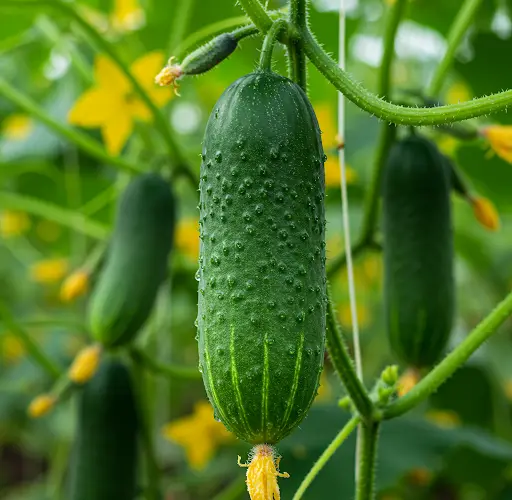How to Encourage Cucumbers to Grow in Clusters with This Simple Fertilization Method
Cucumbers are a favorite crop among gardeners, but ensuring a high yield with healthy, vigorous plants requires proper care and nutrition. One highly effective method to stimulate cucumber growth and maximize fruit set is through targeted fertilization. This method enhances the formation of fruit clusters, prevents yellowing and wilting of young cucumbers, and significantly increases overall yield. Whether growing cucumbers in a greenhouse or open ground, this simple yet powerful technique can help gardeners enjoy an abundant harvest.
The Importance of Proper Fertilization for Cucumbers
Cucumber plants are heavy feeders, meaning they require a steady supply of nutrients to thrive. Inadequate nutrition can lead to weak plants, poor fruit development, and premature dropping of flowers or small cucumbers. By applying the right type of fertilizer at the correct time, gardeners can encourage robust plant growth and maximize productivity.
One of the most effective fertilization techniques for cucumbers involves using boric acid. This inexpensive yet powerful nutrient plays a crucial role in plant metabolism, promoting flower formation and fruit setting. Boron is essential for cell division, carbohydrate movement, and hormone regulation, all of which contribute to healthy cucumber production.
Preparing and Applying the Fertilizer
Using boric acid as a foliar or root application is an easy and efficient way to boost cucumber yields. Here’s a step-by-step guide to preparing and applying this fertilizer:
- Dissolving Boric Acid – Start by taking one tablespoon of boric acid powder and dissolving it in a small amount of hot water. Boric acid is more soluble in warm or hot water, so stirring it thoroughly will ensure proper mixing.
- Diluting the Solution – Once the boric acid is completely dissolved, gradually add water to bring the total volume up to 20 liters. This dilution ensures that the solution is safe for the plants and allows for even distribution during application.
- Applying the Fertilizer – The boric acid solution can be applied in two ways:
- Root Application: Water the plants at the base, making sure to apply approximately one liter of solution per plant. Ensure the soil is already moist before application to allow for proper absorption.
- Foliar Spray: Use a spray bottle or garden sprayer to apply the solution directly to the leaves. Spraying should be done in the early morning or late evening to prevent leaf burn from direct sunlight.
- Frequency of Application – To maximize benefits, apply this fertilizer once every two weeks during the growing and flowering period. Regular application ensures a continuous supply of nutrients, leading to healthier plants and more cucumbers.
Benefits of Boric Acid Fertilization
The application of boric acid as a fertilizer offers numerous advantages, including:
- Enhanced Flower Formation – Boron plays a vital role in flower development, ensuring a higher percentage of flowers develop into fruit.
- Increased Fruit Set – Proper boron levels help prevent flowers from dropping prematurely, leading to more cucumbers per plant.
- Prevention of Yellowing and Wilting – A well-nourished plant is less susceptible to nutrient deficiencies that cause yellowing, wilting, or misshapen fruit.
- Stronger Plant Structure – Boron contributes to cell wall formation, making cucumber plants more resilient to environmental stressors.
- Prolonged Harvest Period – Regular feeding with boric acid extends the fruiting season, allowing for an extended harvest period with consistently high yields.
Additional Tips for Maximizing Cucumber Growth
While fertilization is crucial, additional best practices can further enhance cucumber growth and yield:
- Proper Watering – Cucumbers require consistent moisture, especially during flowering and fruiting stages. Drip irrigation or deep watering methods can help maintain optimal soil moisture levels.
- Mulching – Applying a layer of mulch around cucumber plants helps retain soil moisture, regulate temperature, and reduce weed competition.
- Pollination Support – If growing cucumbers in a greenhouse, hand pollination may be necessary to ensure adequate fruit set. Encouraging pollinators, such as bees, in outdoor gardens also helps improve yields.
- Regular Pruning – Removing excess lateral vines and yellowing leaves can improve airflow around the plants, reducing the risk of fungal infections and promoting better fruit development.
Conclusion
Using boric acid as a fertilizer is a simple yet highly effective way to enhance cucumber production. By stimulating flower formation, increasing fruit set, and promoting overall plant health, this method helps gardeners achieve impressive yields. Whether growing cucumbers in a greenhouse or open field, incorporating this fertilization technique into a regular gardening routine will lead to healthier plants and a bountiful harvest. With proper care, including watering, mulching, and pruning, cucumber plants will thrive, providing an abundance of fresh and delicious cucumbers throughout the season.



